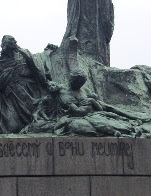 |
| The Jan Hus Memorial in the Old Town Square. |
Jan Hus was a Bohemian Reformer who was into reforming a hundred years before Martin Luther came along. He was Catholic (like everybody else at the time) but he had some disagreements with the Catholic Church, including having problems with indulgences, papal authority, and the sacraments. He was burned at the stake on July 6th, 1415. This monument was erected on the 500th anniversary of his death.
There are three groupings of figures behind Jan Hus on the monument. To his left, there are several standing and crouching figures. The one fellow is holding a wine cup. The wine cup was a Hussite symbol because of the fact that Hus said that everyone should be able to take the wine at communion in the church. It is one of those political symbols (like the beggar's purse for Dutch Protestants) which is a little odd at first glance--or even second and third.
To Hus's right, are a pile of dead bodies. These represent Hussite martyrs and Czech martyrs generally, memorializing those who died for nationalist causes as well as those who died in religious disputes.
 |
| The Jan Hus Memorial from the rear. |
The words on the memorial (according to the Prague tourism guide because I could not make out the words enough to try to translate it myself), include a quote from Jan Hus and quotes from the Hussite warrior anthem:
"Love each other and wish the truth to everyone”
“Live, nation sacred in God, don´t die”,
“Who are the warriors of God and his law”
“I believe, that the anger thunders will cease and that the government of your affairs will return to your hands, Czech folk”
(I am not certain that the Prague tourism guide translated with an ear to the poetry of the thing.)
(I am not certain that the Prague tourism guide translated with an ear to the poetry of the thing.)
Jan Hus was a hugely popular figure not so much because he was into reform or (sort of) not into being a Catholic (about 60% of Czechs are agnostic or atheist so they couldn't really care less about this) but because he is a nationalist hero. The way it works out in Czech history stories, Jan Hus was a Czech, who stood up for what the Czechs believed in, on behalf of the Czech people, in opposition to a massive, international power which sought to strip the Czechs of their national and cultural identity. In Hus's time, that power was the Roman Catholic Church. In Karel Havlicek Borovsky's time, it was the Germans, in Vaclav Havel's time, it was the Soviet Union. So, while Protestants see Hus as a proto-Protestant religious hero, the Czechs seem him as a Czech nationalist political hero.
 |
| Týn Church, from the Old Town Square. This church was a Hussite church until it got taken back over by the Catholics. Note the statue on the left between the tops of the Christmas market stalls. |
 |
| Bethlehem Chapel. The church at which Jan Hus was a preacher. |



No comments:
Post a Comment